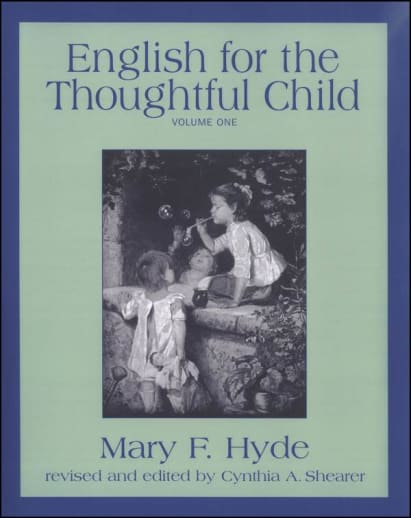Charlotte Mason published her book Home Education in 1886 and practiced her educational approach in Ambleside, in the heart of the English Lake District, in 1892. Using English for the Thoughtful Child is like stepping back into a kinder, gentler, less hustle-bustle time. These courses, based on teacher-student interaction, are a gentle introduction to language arts. Utilizing a wholistic language approach, there are wholesome classic literature excerpts, narration, dictation, memorization, nature lessons, picture lessons, beginning grammar, and both oral and written composition. Lessons are self-contained and the books are very easy to use with short, manageable exercises and assignments. There are about 60 lessons per book with a recommended pacing of 1-2 lessons per week. Space is provided for student work. Revisions of older books, these are complete with quaint, period illustrations. The sequel contains all the distinctive features of the original but takes the instruction to a slightly more advanced level.
English for the Thoughtful Child
Description
At a time when writing programs seem to be moving irresistibly toward infinite complexity, it's nice to find a simple one. English for the Thoughtful Child is an introduction to composition for elementary students that doesn't rely on frills and games to teach—each lesson is self-contained and ready for both teacher and student with no need for preparation.
Based on two early-20th century grammar/composition texts, Cynthia Shearer's volumes combine elements of the Charlotte Mason method and a more straightforward grammar approach. Students both practice verbal narration (telling a story back to the teacher in their own words) and write sentences and stories independently. If you're looking for an easy-to-implement but thoroughly educational composition course for younger kids, this is probably it.
A Simply Grammar-like course for a younger child, again following the Charlotte Mason approach. It contains everything you need for language arts - wholesome classic literature excerpts, narration, dictation, memorization, and composition. Lessons are self-contained and the book is very easy to use with short, manageable exercises and assignments. Like Simply Grammar, this volume is also a revision of an older book, complete with quaint, but stimulating, period illustrations.
| Product Format: | Softcover Book |
|---|---|
| Grades: | 2-3 |
| Brand: | Greenleaf Press |
| Author: | Mary F. Hyde |
| ISBN: | 9781882514076 |
| Length in Inches: | 10 |
| Width in Inches: | 8 |
| Height in Inches: | 0.5 |
| Weight in Pounds: | 0.65 |
| Ages: | 7 - 12 |
| Pages: | 120 |
| Publication Date: | 7/1/1990 |

